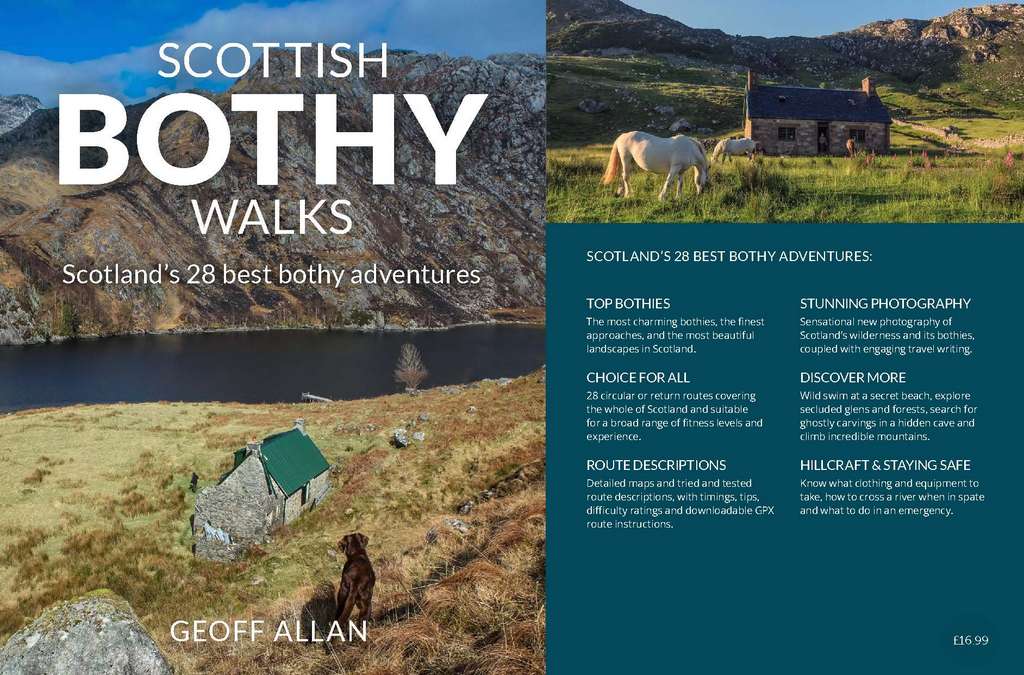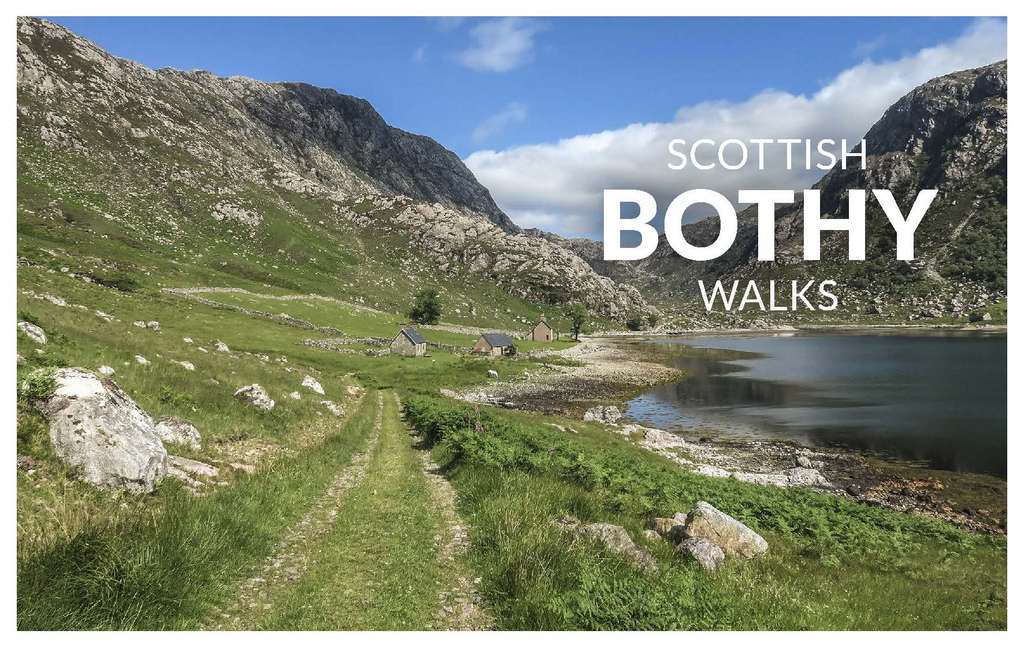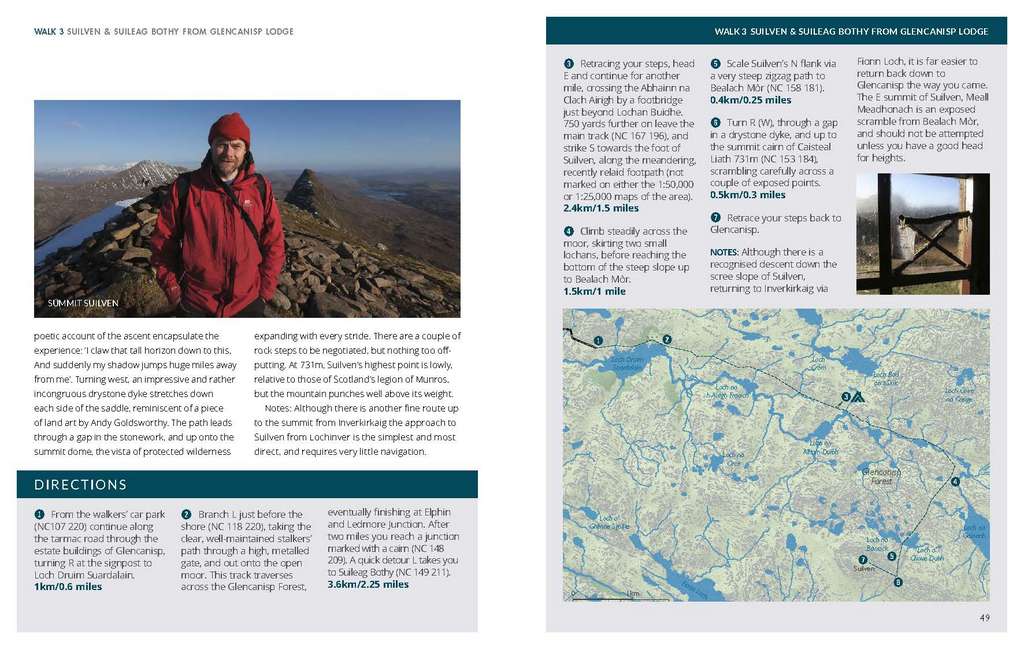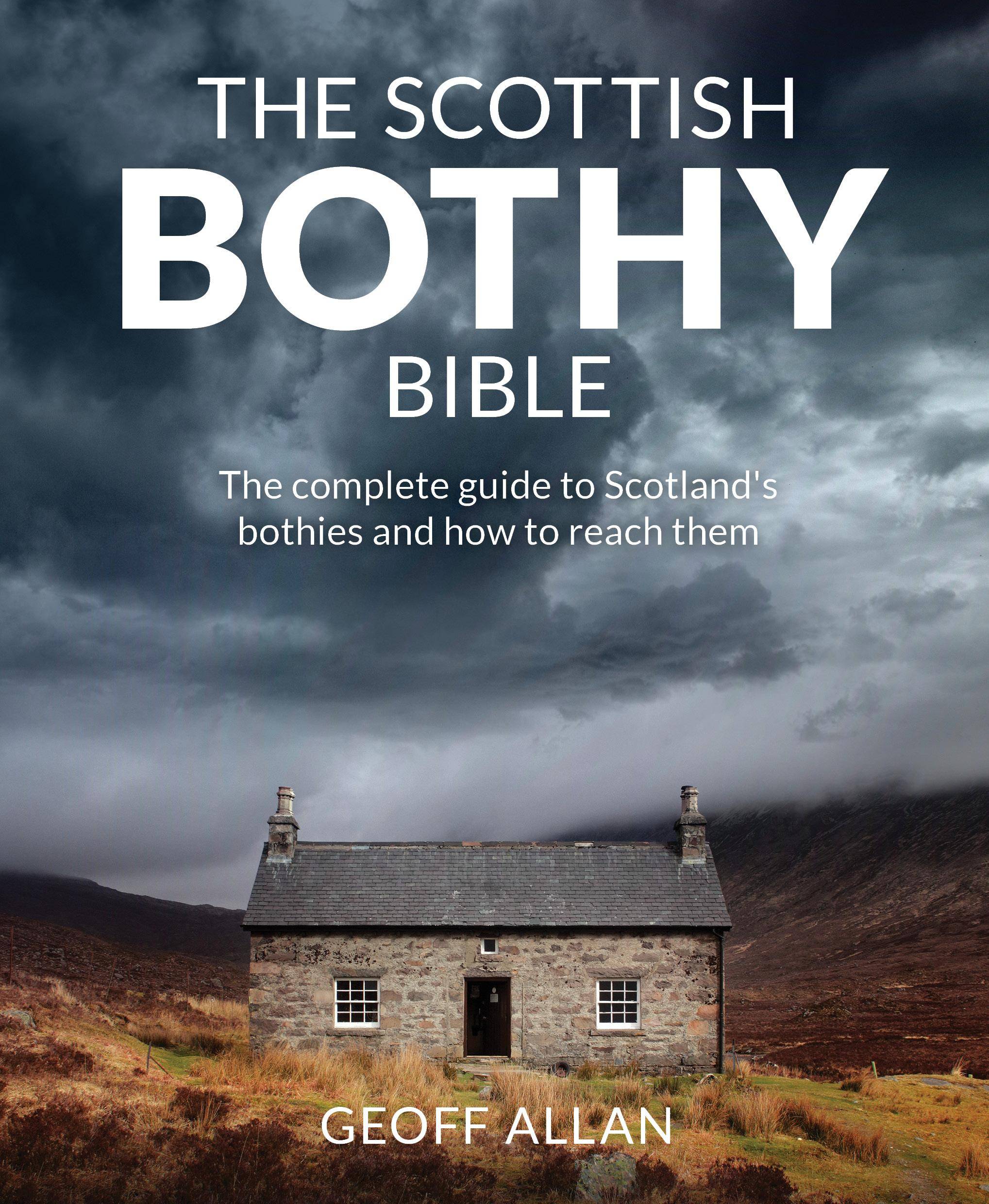SCOTTISH BOTHY WALKS
Scottish Bothy Walks is the sequel to the best-selling Scottish Bothy Bible and describes 28 sensational walking adventures to Scotland’s finest bothies. Choosing his favourite bothies as the focal point, Geoff Allan guides the reader on a mix of day walks and multi-day excursions, highlighting the incredible mountains, wildlife, geography and history that you will find along the way.

Combining beautiful photos, detailed route descriptions, points of interest and downloadable instructions, this is the ultimate companion for bothy-lovers and those exploring Scotland’s wilds, written by Scotland’s premier bothy expert.
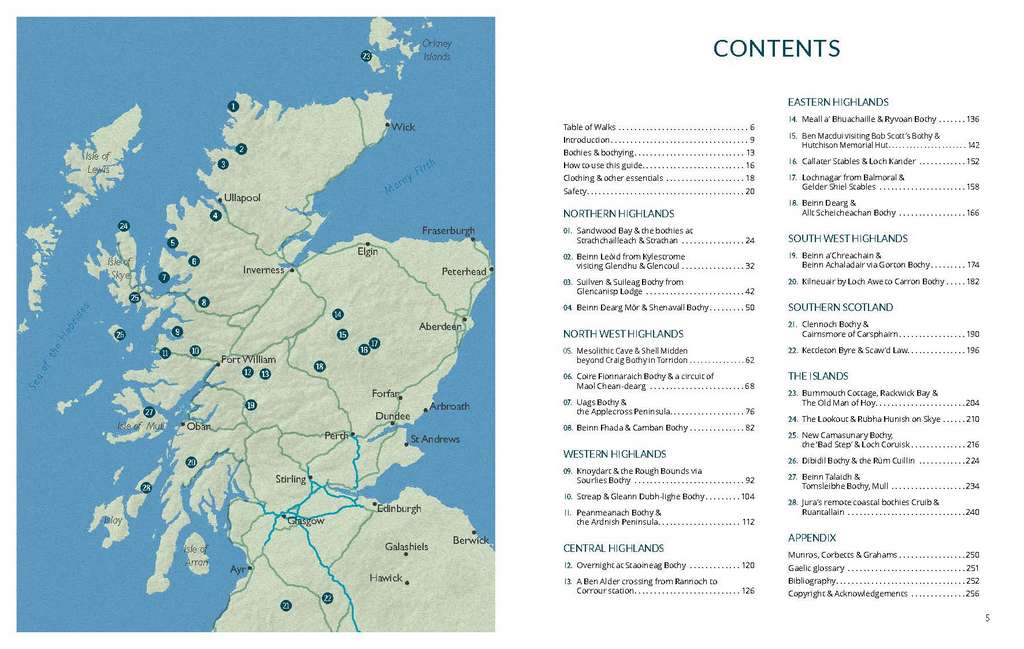
Including:
Top Bothies – The most charming bothies, the finest approaches and the most beautiful landscapes in Scotland.
Choice for all – 28 circular or return routes covering the whole of Scotland and suitable for a broad range of fitness levels and experience.
Route Descriptions – Detailed maps and tried and tested route descriptions, with timings, tips, difficulty ratings and downloadable GPX route instructions.
Sensational new photography – of Scotland’s wilderness and its bothies, coupled with engaging travel writing.
Discover more – Wild swim at a secret beach, explore secluded glens and forests, search for ghostly carvings in a hidden cave and climb incredible mountains.
Hillcraft & staying safe – Know what clothing and equipment to take, how to cross a river when in spate and what to do in an emergency.


Geoff Allan
Travel writer, photographer and outdoor guide based in Edinburgh, Geoff Allan is also the Mountain Bothies Association’s maintenance officer for Dibidil Bothy on Rùm. He has hiked and biked to every well-known Scottish bothy and is the author of The Scottish Bothy Bible.
A bothy is a simple shelter in remote country for the use and benefit of all who love being in wild and lonely places. Please support the Mountain Bothies Association (MBA) which maintains all the wonderful bothies described in this guide.
www.mountainbothies.org.uk

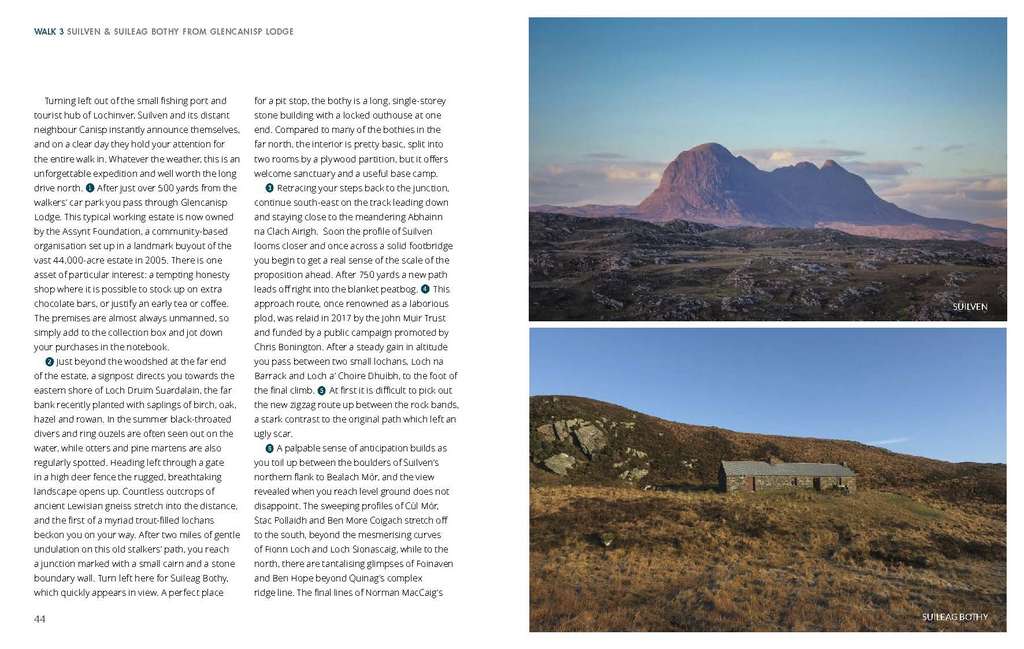
Featured Walks and Bothies
Table of Walks 6
Introduction 9
Bothies & bothying 13
How to use this guide 16
Clothing & other essentials 18
Safety 20
Northern Highlands
Sandwood Bay & the bothies at Strathchailleach & Strathan 24
Beinn Leòid from Kylestrome
visiting Glendhu & Glencoul 32
Suilven & Suileag Bothy from
Glencanisp Lodge 42
Beinn Dearg Mòr & Shenavall Bothy 50
North West Highlands
Mesolithic Cave & Shell Midden
beyond Craig Bothy in Torridon 62
Coire Fionnaraich Bothy & a circuit of
Maol Chean-dearg 68
Uags Bothy &
the Applecross Peninsula 76
Beinn Fhada & Camban Bothy 82
Western Highlands
Knoydart & the Rough Bounds via
Sourlies Bothy 92
Streap & Gleann Dubh-lighe Bothy 104
Peanmeanach Bothy &
the Ardnish Peninsula 112
central Highlands
Overnight at Staoineag Bothy 120
A Ben Alder crossing from Rannoch to Corrour station 126
Eastern Highlands
Meall a’ Bhuachaille & Ryvoan Bothy 136
Ben Macdui visiting Bob Scott’s Bothy & Hutchison Memorial Hut 142
Callater Stables & Loch Kander 152
Lochnagar from Balmoral &
Gelder Shiel Stables 158
Beinn Dearg &
Allt Scheicheachan Bothy 166
South West Highlands
Beinn a’Chreachain &
Beinn Achaladair via Gorton Bothy 174
Kilneuair by Loch Awe to Carron Bothy 182
Southern Scotland
Clennoch Bothy &
Cairnsmore of Carsphairn 190
Kettleton Byre & Scaw’d Law 196
The Islands
Burnmouth Cottage, Rackwick Bay &
The Old Man of Hoy 204
The Lookout & Rubha Hunish on Skye 210
New Camasunary Bothy,
the ‘Bad Step’ & Loch Coruisk 216
Dibidil Bothy & the Rùm Cuillin 224
Beinn Talaidh &
Tomsleibhe Bothy, Mull 234
Jura’s remote coastal bothies Cruib & Ruantallain 240
Appendix
Munros, Corbetts & Grahams 250
Gaelic glossary 251
Bibliography 252
Copyright & Acknowledgements 256
Photography
View more photos from the book here
https://photos.app.goo.gl/jtuR4SXrzcZ8MjQTA
More about the book, from the author
Bothy Walks is a natural companion to my first book, The Scottish Bothy Bible. In this volume, I showcase some of the best bothies in the country, setting out a range of short hikes, mountain climbs and multi-day expeditions using these unique shelters as a focal point. Over the last two years I have eagerly retraced my steps around the bothy network, checking out routes for inclusion here, and adding a raft of new images to my photographic archive. My aim has been to tempt you out into Scotland’s rugged and beautiful landscape, whatever your level of ability. The walks range from a stroll along the cliffs above Rackwick Bay to the Old Man of Hoy on the Orkney Archipelago, to a challenging traverse of the ‘Bad Step’ on Skye. As well as including all the essential technical details, each entry offers a taste of what makes the area special, from its unique geology, wildlife and flora, to the intriguing history and culture of its people. And there are a few personal reminiscences along the way…
Even after more than 30 years spent exploring Scotland’s nooks and crannies, I still feel a surge of anticipation and delight when I see a bothy in the distance, even if I have visited it many times before. My adventures into the bothy world began during my student days in the late-1980s, when I became an enthusiastic member of the Edinburgh University Mountaineering Club. By my second year of study, I was bothy secretary for the club hut, Glenlicht House, tucked away beneath the mountains of Kintail, and had begun to seek out bothy locations. At the time, these were closely guarded secrets, held only by a knowledgeable few. One of my first discoveries was the Mountain Bothies Association (MBA) bothy at Camban (described in Walk 8), which sits on the lonely pass between Glen Affric and Gleann Lichd. I vividly remember staring up at the mist-laden Munros surrounding the bothy, not quite believing that this isolated refuge was free to use by anyone who had the wherewithal to get there. Soon I had acquired a prized copy of the MBA bothy grid references (finally published online by the MBA in 2009), and stumbled upon Irvine Butterfield’s 1972 Survey of Shelters in Remote Mountain Areas of the Scottish Highlands. This treasure trove of information became the basis of my own precious bothy list, and inspired an even greater passion to travel around the country.
Through my love affair with bothies I have developed an intimate personal relationship with the Scottish Highlands, a bond that has only intensified since the autumn of 2011, when I hit upon the idea of producing a countrywide bothy guide. Without the use of a car, it took five years to complete the survey and research all the background material – the vast majority of fieldwork undertaken using my trusty bike and public transport. With the luxury of time, I have been lucky enough to rediscover the country at a slower pace and get a deeper feel for the history that has played out across the landscape over millennia. The Scottish Bothy Bible was finally published in March 2017 and went on to win UK Travel Guidebook of the Year.
Much thought has been invested in choosing the walks and bothies in this guide. The selection represents my absolute favourite bothy locations with the most memorable and beautiful approaches. You will find routes that not only range over the whole of Scotland, but also are suitable for a broad spectrum of fitness levels and experience. I have included a mix of day walks and multi-day adventures, and have been conscious not to create itineraries that are too complex or that replicate suggestions in other Scottish walking books. All the day walks return to the same location, whether circular or there-and-back, so there is no requirement for two cars or an anxious hitch-hike to retrieve a vehicle. It is also important to emphasise that each bothy is a worthy objective in itself, as well as a base from which to climb mountain tops or explore additional places of interest. On a dreich morning or a lazy sunny afternoon I have often set out to visit a bothy just to have a look around. Happiness comes from the satisfaction of having a simple objective combined with the opportunity to venture off the beaten track.
Creating The Scottish Bothy Bible was a life-changing experience for me, and I hope Scottish Bothy Walks will encourage even more people out into the hills. Enjoy the descriptions of the walks and the photographs that accompany them. Hopefully they will inspire you to make your own journeys and build lasting relationships with the bothies and mountains that I know and love.
‘A simple shelter in remote
country for the use and benefit of all who love being in wild and lonely places’.
Definition from the MBA members’ handbook
Scotland’s bothies are a loose collection of shepherds’ cottages, estate houses and abandoned crofts that have been saved from ruin and renovated. They form a network of basic shelters located throughout the country’s most remote and uninhabited regions. Freely available for anyone to use as a lunch stop, or to stay in overnight, bothies have been used by mountaineers and stravaigers for well over a hundred years and become integral to Scotland’s outdoor culture.
In very simple terms, there are many derelict properties scattered across the Scottish landscape because of the waves of depopulation that began in the mid- to late-18th century and did not ease until after World War II. The initial driving force behind the exodus was a process of forced evictions known as the ‘Highland Clearances’. People then continued to abandon their communities when harvest failures led to illness and famine, with many leaving for the industrial heartland that grew rapidly in Lowland Scotland through the Victorian era.
The term bothy derives from the Gaelic bothan (via the Old Irish both) meaning hut, and originally described rough-and-ready accommodation provided by landowners for farm labourers or estate workers. More recently the term has become synonymous with an idea of sanctuary and shelter. This cultural transition began in the 1930s, with the rise in popularity of hillwalking among the urban populations of Glasgow, Edinburgh and Aberdeen. Short of money, but with more leisure time on their hands, groups of mainly young men used these partly derelict cottages as places to congregate and sleep for free during hard-earned weekends. In some cases this practice was clandestine, but increasingly, various estates gave their tacit consent.
The rural exodus following World War II left an increasing number of farmhouses unoccupied, and walkers simply started using them as somewhere to stay overnight. By the 1960s, however, the fabric of many of these properties began to suffer through misuse and lack of maintenance. A few were cared for by climbing clubs, but the remainder received little attention. I strongly believe the bothy tradition in its current form would not have endured without the invention of the MBA, which came into existence in 1965. Bernard Heath, a keen cyclist and hillwalker was inspired by a chance remark in a bothy book suggesting the establishment of a club to keep bothies in good repair. He and a few of his friends decided to restore the ruins of Tunskeen Farm in Galloway, and the following November a group of like-minded individuals gathered in nearby Dalmellington village hall where the Mountain Bothies Association was born. During the next five decades the MBA extended its renovation work across the country, as well as taking over the upkeep of many bothies maintained by various climbing clubs. Today there are over 80 MBA bothies in Scotland as well as 21 in England and Wales. In 2015, when the organisation celebrated its 50th anniversary, it received The Queen’s Award for Voluntary Service – the highest accolade for a voluntary group in the UK.
WHAT TO EXPECT
Bothies come in many shapes and sizes, but the most common configuration is the classic two-roomed cottage referred to by its Scots term, but and ben. The ‘but’ referring to the kitchen and living room, and the ‘ben’ the bedroom. Accommodation is very rudimentary, and in almost all cases there is no gas, electricity, tap, or toilet. You should expect only a wind- and waterproof building that offers somewhere dry to sleep. If you are staying overnight, you will need to carry in all the equipment you would normally take camping, plus candles and, if there is a fireplace, fuel to burn. As a bare minimum, bothies will have a table and a couple of chairs, but many also have sleeping platforms and stoves. Water comes from a nearby stream and, although some bothies have latrines or loos, answering calls of nature will involve a walk and the use of a spade.
Bothies can look romantic, but in reality they can be cold, dusty, damp, and pretty dark. Yet in the evening, with the fire blazing, candles burning, hot food on the table and a glass of wine at your elbow, the place is transformed. Some (myself included) just like to go ‘bothying’ – setting off for the weekend without any other objective in mind – and many bothies have been adopted as a home from home. Evenings can be peaceful or convivial, so respect other users as well as the bothy itself. Each shelter has at least one dedicated MBA maintenance officer who volunteers their services to look after the fabric of the building and when major renovations are required, the MBA organises work parties. I would wholeheartedly recommend joining the MBA to support all their good work.
LOCATING BOTHIES
Bothies differ from other systems of mountain huts and refuges around the world in a number of subtle and distinctive ways. Because only a very small number have been purpose-built, the location of the majority is fairly random. They are not necessarily close to a particular peak or spaced at equal distances along a recognised long-distance walk. Neither are they tied to any specific National Park. They are found right across the country, some in very remote places that are rarely visited. Another intriguing element is the past reticence about advertising the network. Except in a very few cases, the word bothy has not been printed on any OS maps; only the name of the building. And on the ground there are few signposts to point the way. As I explain in the next section, you cannot rely on this guide alone, but in combination with the right OS map you should be able to find your way with ease.
The Scottish bothy bible was the first ever complete guide book to Scotland’s bothies. Winner Travel Guidebook of the Year 2017. You can buy the PDF digital version of the book here or the Kindle version here.

